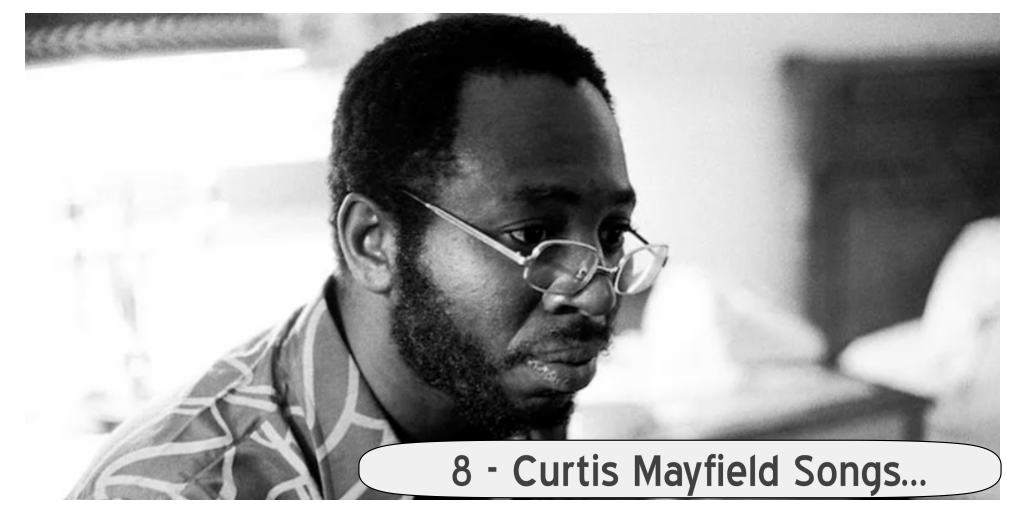(ThyBlackMan.com) When most people think of Curtis Mayfield, they think of the big ones—“Move On Up,” “Superfly,” or maybe “People Get Ready.” And for good reason. Those songs are legendary, stitched into the fabric of soul, funk, and protest music. But if you only stick to the hits, you’re missing out on a treasure trove of deeply moving, often overlooked gems that showcase the full emotional range and genius of Curtis Mayfield.
For me, what makes Curtis so timeless isn’t just his voice or his grooves—it’s the way he could be politically sharp one minute and tender the next. His music doesn’t just speak to the moment; it speaks to the soul. Digging into his lesser-known songs feels like discovering old letters you never knew were written for you. These tracks might not have topped charts, but they have a quiet kind of power—the kind that lingers.
So if you’re ready to go beyond the obvious and find the Curtis Mayfield that doesn’t always make the playlists, this list is for you. Let’s explore 8 lesser-known Mayfield tracks that deserve your time, your headphones, and maybe even a spot on your all-time favorites list.

1. “So In Love”
“So In Love” is often buried beneath the weight of its politically charged parent album, There’s No Place Like America Today. While that project is lauded for searing social commentaries like “Billy Jack” and “Hard Times,” this track reveals the understated romanticism Curtis Mayfield was always capable of. It’s a quiet storm wrapped in strings and subtle horns—a meditative ballad that’s both emotionally direct and musically restrained.
The song’s vulnerability is what makes it so magnetic. Curtis doesn’t opt for vocal theatrics here; instead, he relies on the intimacy of his falsetto and a lyrical minimalism that somehow feels overflowing with warmth. It’s a whispered declaration rather than a shouted vow, and that’s what makes it unforgettable. His voice—soft, contemplative, pleading—wraps around the line “So in love, you do so many things with a smiling face” like it’s a personal prayer.
Production-wise, it’s a masterclass in economy. The groove is slow and deliberate, allowing space for the emotion to resonate. The restrained arrangement gives the track a cinematic quality, perfect for quiet Sunday mornings, romantic evenings, or reflective drives through the city. There’s something healing in its simplicity, something nostalgic yet unforced.
For listeners drawn to the lo-fi soul revival of recent years—think Daniel Caesar, Snoh Aalegra, or Leon Bridges—“So In Love” offers a blueprint. It’s a reminder that love songs don’t always have to beg for attention. Sometimes, all they have to do is be—still, pure, and full of heart. Curtis Mayfield mastered that in a way few ever could.
2. “Tripping Out”
“Tripping Out” is a late-career jewel that shows Mayfield still had plenty of magic to offer in the 1980s. The track opens with one of the smoothest bass grooves in his catalog, instantly setting a velvety tone. This isn’t just love music—it’s grown love music. Mature, sensual, and steeped in romantic awareness, “Tripping Out” deserves its place among Mayfield’s most sensual songs.
Lyrically, the track is a confessional wrapped in funk. The phrase “tripping out” isn’t just about being overwhelmed by desire—it’s about surrendering to it. There’s a dreamy quality to Curtis’ falsetto as he glides through lines like “Tripping out, tripping out, over you, babe” expressing a kind of quiet ecstasy that’s more about connection than lust. It’s this emotional honesty that elevates the track above typical slow-jam fare.
What stands out most is the song’s luxurious production. The layers of harmony are rich but never overpowering, while the groove remains unshakably smooth. A gentle blend of electric piano, guitar licks, and rhythm-section precision gives the track a satin finish. It’s polished without being slick—soulful without being overly sentimental.
Fans of modern R&B hybrids—think Anderson .Paak, Terrace Martin, or even Sade’s more groove-based work—will hear a direct lineage in this song. “Tripping Out” is for those nights when you want the room to dim itself and let the music wrap around you like velvet. Curtis knew how to soundtrack love, even in its most dizzying forms.
3. “Keep On Trippin”
“Keep On Trippin’” is the kind of deep cut that only true Curtis Mayfield fans speak of in reverent tones. It’s less about the hook and more about the vibe—a gritty, thoughtful piece that blends the psychedelic soul palette Mayfield had been refining since Superfly. The bass throbs like a warning heartbeat while the horns swirl and tease, giving the song a sense of motion and unease.
Curtis steps into the role of the quiet observer here. The title might sound playful, but this is no carefree jam. “Keep On Trippin’” is a socially conscious warning disguised as funk. It tells listeners not to fall into complacency, not to be seduced by surface pleasures, and most of all—not to stop thinking. Mayfield’s vocals, though subdued, carry the weight of a weary prophet trying to shake us from our collective fog.
The brilliance of the track lies in its ambiguity. It never tells you exactly what to do or think—it just nudges you to stay awake, stay alert. The groove lulls you, but the lyrics keep your mind engaged. It’s funk for thinkers. Protest music for headphones.
Decades later, “Keep On Trippin’” remains a crucial addition to any playlist focused on conscious soul or political funk. It belongs in conversations about Marvin Gaye’s What’s Going On or Gil Scott-Heron’s catalog. It’s a rare balance of message and mood, a song that whispers where others shout—and that whisper carries farther than you’d expect.
4. “The Other Side of Town”
“The Other Side of Town” might be the most quietly devastating song Curtis Mayfield ever recorded. Found on his debut solo album Curtis, the track is a haunting lament for the forgotten. It doesn’t hit you with anger—it hits you with despair. And in that sadness, it reveals a more profound sense of injustice than rage ever could.
The opening lines—”Little child / Runnin’ wild / Watch a while / You’ll see he never smiles”—are among the most poignant lyrics in all of 1970s soul. Mayfield isn’t preaching here; he’s mourning. The sparse arrangement—anchored by piano, ghostly strings, and a distant beat—feels like a slow, painful walk through the ruins of the American dream. His falsetto doesn’t soar here—it aches, dripping with empathy and exhaustion.
What makes “The Other Side of Town” so powerful is its subtlety. It’s not trying to rouse you to action. It’s not flashy. It’s simply bearing witness to pain—Black pain, urban pain, generational pain—with a grace that few artists could ever match. It asks nothing of you but to listen. And that act of listening becomes transformative.
In today’s world—where conversations around systemic inequality, redlining, and social neglect continue to evolve—this song feels eerily present. It could underscore a documentary, live on as a spoken-word sample, or be revisited by socially conscious artists as a sample or cover. Curtis Mayfield didn’t just speak to the moment; he predicted the future. And “The Other Side of Town” is a chilling reminder of that prophetic power.
5. “Love Me, Love Me Now”
This disco-era Mayfield cut didn’t chart high but deserves a serious second look. “Love Me, Love Me Now” combines the lushness of 1970s orchestral funk with Curtis’ signature emotional pull. The strings glide with cinematic flair, the percussion pops with a subtle disco pulse, and Mayfield’s falsetto dances right in the center—effortlessly romantic, endlessly groovy.
But don’t be fooled by the upbeat production—the lyrics are all yearning. Curtis is pleading for immediacy in love, for connection in a world that seems to constantly delay or deny it. There’s a desperate energy beneath the polished rhythm, a sense that he’s not just asking for love—he’s begging for it, as if it’s the only thing standing between him and emotional collapse. This tension between the joyful music and the longing in the lyrics is what makes the track so emotionally rich.
“Love Me, Love Me Now” offers more than just a catchy hook—it’s a full-bodied experience. The arrangements are layered with care: plucked strings echo with urgency, synths bubble underneath, and Mayfield’s voice never overpowers, instead guiding the song like a master conductor. It’s a blend of disco flair and soul honesty, a rare feat that only a seasoned artist like Curtis could pull off with this much finesse.
In today’s age of disco-revival and soulful pop, the track holds surprising relevance. It could easily sit beside the funky optimism of Jamiroquai, the emotional club anthems of Jessie Ware, or even the retro-leaning shimmer of Dua Lipa’s Future Nostalgia. DJs looking for a deep cut that bridges vintage and modern energy should dig this one out—it’s the kind of track that makes a room pause, smile, and sway.
6. “We the People Who Are Darker Than Blue”
While hardcore fans recognize this song, it doesn’t get the widespread acclaim it truly deserves. “We the People Who Are Darker Than Blue” is one of Curtis Mayfield’s most powerful compositions—a sobering meditation on race, division, and internal healing within the Black community. It’s both intimate and epic, a soul ballad infused with quiet rage and unwavering dignity.
With a title like that, you’d expect something overtly militant. But Mayfield surprises by offering something more nuanced: a heartfelt call for introspection and unity. Rather than condemning external forces, he turns the mirror inward. “We people who are darker than blue / Are we gonna stand around this town and let what others say come true?” It’s a challenge, not a condemnation—a plea for strength, discipline, and mutual respect.
Musically, the track is lush and orchestral. Strings rise like waves, brass flares add gravitas, and the rhythm section keeps things grounded without losing the emotional momentum. Curtis’ vocal delivery is pristine and poetic, teetering between sermon and soul ballad. Every word feels intentional, every pause pregnant with thought. You don’t just listen to this track—you meditate on it.
This song could play alongside modern spoken word pieces, conscious rap, or social justice documentaries and still feel urgent and contemporary. Artists like Kendrick Lamar, Rapsody, or Common have all tapped into this kind of introspective activism. “We the People Who Are Darker Than Blue” is the original blueprint—Mayfield wasn’t just singing to the community, he was singing from within it. His voice still resonates like a beacon urging us to rise, reflect, and reform.
7. “You’re So Good to Me”
“You’re So Good to Me” is a song that radiates gratitude and emotional maturity. In a genre known for high drama, heartbreak, and unrequited love, Mayfield offers something almost revolutionary: contentment. He doesn’t overplay his hand. He simply celebrates a love that works—a partner who gives without needing to be asked, who stays through the storms, and whose quiet support feels like sunlight.
The track opens with gentle gliding synths and a cozy horn arrangement, setting the tone like the warmth of a shared blanket. There’s no need for flashy production—this is a moment of peace and praise, not spectacle. Curtis’ falsetto floats effortlessly, wrapping the listener in a gentle embrace. It’s the kind of track that could calm a restless heart or make a weary soul smile.
What’s notable is how universal the message is. “You’re So Good to Me” isn’t tethered to drama, youth, or fantasy—it’s grounded in adult love, the kind that comes with time, trust, and patience. It’s not about fireworks; it’s about the steady, glowing warmth that lasts long after the sparks have faded. That kind of love is rare in music, and rarer still in soul ballads. Mayfield captures it perfectly.
Modern R&B artists could take notes from this track. It feels spiritually connected to the work of Musiq Soulchild, Maxwell, or India.Arie—music that’s rooted in affirmation rather than pain. “You’re So Good to Me” is the soundtrack to relationship longevity. It’s what happily-ever-after sounds like when sung by someone who truly understands what it takes to get there.
8. “Right on for the Darkness”
Few songs in Mayfield’s catalog are as hypnotic or ominous as “Right on for the Darkness.” From the first few bars, the track unfolds like a slow, dense fog—its bassline deep and brooding, the guitar lines drawn out like shadowy figures moving in the background. This is Curtis exploring the abyss of the human soul, confronting themes of illusion, pain, and emotional confusion with brutal honesty.
The lyrics are philosophical and cryptic. “I am blind and I cannot see / You are there, your petty evil don’t bother me.” The song becomes a battle of perceptions, a spiritual tug-of-war between clarity and delusion. Mayfield’s vocals are quieter here, almost ghostly, as if he’s whispering truths from the edge of a dream. His falsetto is less a melody than a guide into introspection.
The arrangement is spellbinding. Electric piano keys echo like broken clocks, guitars sigh like distant thunder, and the strings swell with an eerie elegance. There’s almost no hook—just a repetitive, looping groove that draws you deeper and deeper into its orbit. It’s hypnotic, even meditative. This isn’t a song you dance to or sing along with—it’s one you live inside of.
In a modern context, “Right on for the Darkness” could easily be licensed for a film about grief, addiction, or inner turmoil. It has the same atmospheric weight as tracks by Massive Attack, Portishead, or Moses Sumney. The track doesn’t just suggest pain—it embodies it. And yet, it never loses its dignity. Curtis Mayfield doesn’t flinch when staring into the void. He gives it shape, color, and—somehow—grace.
Curtis Mayfield wasn’t just a singer or a songwriter—he was a storyteller, a spiritual guide, and a mirror held up to both love and injustice. These songs might not get as much radio play or attention as his biggest hits, but that doesn’t make them any less important. If anything, these are the songs where his artistry becomes even more intimate—where you can really hear the man behind the message.
Whether he was writing about social struggle, romantic longing, or inner peace, Curtis always did it with grace and honesty. Listening to these deep cuts today, I’m reminded that great music doesn’t always have to shout. Sometimes, it whispers—and in those quiet moments, it can say the most.
Hopefully, you found a new favorite in this list—or at least a reason to dig a little deeper into Mayfield’s catalog. Trust me, there’s always more to discover. His music has a way of finding you exactly when you need it.
Staff Writer; Jamar Jackson

















Back in the world check it